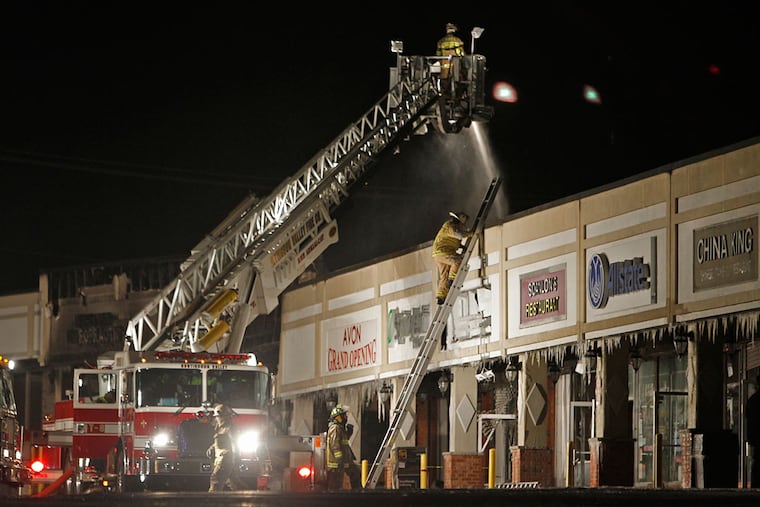Pa.’s venerated tradition of volunteer firefighting is in deep trouble | Opinion
Simply put: It’s getting harder to recruit and retain volunteer firefighters. In the early 1970s, the state had more than 300,000 volunteers. Today that number is closer to 38,000.

In 2001, when Murrey Cohen’s alarm company called to say a smoke detector in the garage was beeping, it took him just six minutes to drive the 2.4 miles home. Still, he missed everything.
By the time he got there, the street was blocked off. Firefighters had broken into the garage and extinguished the fire, which started when a contractor left a lit cigarette butt in a trash can. Cohen’s dog was safe, in custody.
The damage was bad, but it could have been worse: Next to the melted trash can in the garage was a propane tank. “If that had gone off,” the fire marshal told Cohen, “it could have killed three of my men.”
» READ MORE: Philadelphia firefighters pay tribute to John Evans, who died in the line of duty after contracting COVID-19
Cohen shudders to think about what might have happened if the firefighters hadn’t beat him home. “I could only imagine if they had come from six minutes away, what it could have been. It could have been a dead dog, dead firemen, an explosion.”
Luckily, the firefighters were 1.2 miles away, at Ogontz Fire Co. in Cheltenham Township. But they’re not anymore: Recently, the township closed the station, citing its inability to provide enough firefighters to safely operate.
Now, Cohen’s closest fire station is about half a mile further away: “We definitely do not feel as safe without Ogontz there.”
Cohen and his wife, Karen Lecks, are my neighbors. Ogontz was my fire station, too. While the township has reassured residents that the remaining four stations will provide ample coverage, I am worried. The closure of Ogontz Fire Station is a sign of a larger problem facing communities in Pennsylvania.
All of the firefighters at Ogontz were volunteers, like the vast majority — more than 90% — of fire stations in Pennsylvania. And the venerated tradition of volunteer firefighting is in deep trouble.
Simply put: It’s getting harder to recruit and retain volunteer firefighters. In the early 1970s, the state had more than 300,000 volunteers. Today that number is closer to 38,000.
Fire chiefs and volunteer firefighters throughout the state told me that society has lost the social scaffolding that supported volunteer firefighting. Before, volunteers worked close to home, and bosses understood when they had to duck out in the middle of the day. Now, people often work far from their local station, and bosses don’t like losing an employee for an afternoon. Training is also more rigorous — in today’s world, firefighters have to be prepared to face terrorists and active shooters, for instance.
The volunteer shortage primarily affects suburban and rural areas. While Philadelphia is home to the nation’s first volunteer fire company, it now uses career fighters, who get a starting salary of $56,227.
We need to do more to support existing volunteers and recruit new ones.
» READ MORE: How volunteer fire, ambulance companies are facing the coronavirus pandemic in Philly suburbs
Rules such as the Fair Labor Standards Act may limit the ways stations can compensate volunteers, but some stations are starting to offer stipends, either per shift or at the end of the year. (Note to stations: $10 for an overnight isn’t enough.)
To retain volunteers, stations can offer tax credits, life insurance policies, mortgages, or tuition reimbursement. FireVest, in Allegheny County, gives full scholarships for an associate degree or certificate program at the community college in exchange for five years at a volunteer fire department. A recent bill in the Pennsylvania Senate proposed a $500 tax credit for active volunteers who have spent two full years responding to at least 20% of emergency calls.
Several dozen of the state’s fire departments have taken the pressure off volunteers by adding career firefighters, including in our region in Upper Merion, Upper Providence, Lower Merion, and Upper Moreland. Another potential solution is “regionalization,” whereby stations stop working as individual silos and pool equipment and staff. Calls go to the closest available station, even if in a different township.
Some of these solutions involve money, which may have to come from taxpayers. But COVID-19 has taught us, in a deeply painful way, the value of first responders — the brave few who run toward a disaster, not away from it. Volunteer firefighters die in the line of duty every year. We need to show them their service matters.
I know I’m not the only one who feels this way. My neighbor Karen Lecks told me she would gladly pay more taxes to get back Ogontz Fire Station: “I would do it, without a doubt.”
Alison McCook is a journalist based in Wyncote and a commentary editor at Knowable Magazine.